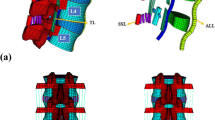Abstract
Purpose
To assess and characterize the sacrum angular displacements in response to lumbar lordosis after lumbar/lumbosacral fusion.
Methods
A finite element model of the lower lumbar spine-pelvis was established and used to simulate the posterior fusion at L3–L5 and L4–S1. The lordosis angle in the fusion segments was set to five different conditions with respect to the intact model: 10° less than intact, 5° less than intact, same as intact, 5° more than intact, and 10° more than intact. Variations of the sacrum angular displacements with lordosis changes were analyzed under loading setting of axial compression, flexion, extension, lateral bending, and axial rotation.
Results
Compared with the intact lordosis, both increased and decreased lumbar lordosis angles caused the sacrum angular displacements to be increased. The lordosis angle increased by 10° induced the most substantial increase in sacrum angular displacements. In addition, the sacrum angular displacements of the L4–S1 fusion model at different lordosis angles were higher than those of the L3–L5 fusion model.
Conclusion
The sacrum angular displacements occur as a result of the fusion surgery (L4–S1) and the changes in lumbar lordosis.




Similar content being viewed by others
References
Yoshihara H (2012) Sacroiliac joint pain after lumbar/lumbosacral fusion: current knowledge. Eur Spine J 21(9):1788–1796
Ha K-Y, Lee J-S, Kim K-W (2008) Degeneration of sacroiliac joint after instrumented lumbar or lumbosacral fusion: a prospective cohort study over five-year follow-up. Spine 33(11):1192–1198
Ivanov AA, Kiapour A, Ebraheim NA, Goel V (2009) Lumbar fusion leads to increases in angular motion and stress across sacroiliac joint: a finite element study. Spine 34(5):E162–E169
Peterson MD, Nelson LM, McManus AC, Jackson RP (1995) The effect of operative position on lumbar lordosis: a radiographic study of patients under anesthesia in the prone and 90-90 positions. Spine 20(12):1419–1424
Gödde S, Fritsch E, Dienst M, Kohn D (2003) Influence of cage geometry on sagittal alignment in instrumented posterior lumbar interbody fusion. Spine 28(15):1693–1699
Keorochana G, Taghavi CE, Lee K-B, Yoo JH, Liao J-C, Fei Z, Wang JC (2011) Effect of sagittal alignment on kinematic changes and degree of disc degeneration in the lumbar spine: an analysis using positional MRI. Spine 36(11):893
Umehara S, Zindrick MR, Patwardhan AG, Havey RM, Vrbos LA, Knight GW, Miyano S, Kirincic M, Kaneda K, Lorenz MA (2000) The biomechanical effect of postoperative hypolordosis in instrumented lumbar fusion on instrumented and adjacent spinal segments. Spine 25(13):1617–1624
Ivanov A, Kiapour A, Ebraheim N, Goel V (2007) Finite element modeling and analysis of human pelvis. In: Conference of Bioengineering Division of American Society of Mechanical Engineering
Goel VK, Grauer JN, Patel TC, Biyani A, Sairyo K, Vishnubhotla S, Matyas A, Cowgill I, Shaw M, Long R (2005) Effects of charite artificial disc on the implanted and adjacent spinal segments mechanics using a hybrid testing protocol. Spine 30(24):2755
Weisl H (1954) The ligaments of the sacro-iliac joint examined with particular reference to their function. Cells Tissues Organs 20(3):201–213
Eichenseer PH, Sybert DR, Cotton JR (2011) A finite element analysis of sacroiliac joint ligaments in response to different loading conditions. Spine 36(22):E1446–E1452
Dalstra M, Huiskes R, Van Erning L (1995) Development and validation of a three-dimensional finite element model of the pelvic bone. J Biomech Eng 117(3):272
Goel V, Monroe B, Gilbertson L, Brinckmann P (1995) Interlaminar shear stresses and laminae separation in a disc: finite element analysis of the L3–L4 motion segment subjected to axial compressive loads. Spine 20(6):689–698
Goel VK, Ramirez SA, Kong W, Gilbertson LG (1995) Cancellous bone Young’s modulus variation within the vertebral body of a ligamentous lumbar spine–application of bone adaptive remodeling concepts. J Biomech Eng 117(3):266
Chen C-S, Cheng C-K, Liu C-L (2002) A biomechanical comparison of posterolateral fusion and posterior fusion in the lumbar spine. J Spinal Disord Tech 15(1):53–63
Miller JA, Schultz AB, Andersson GB (1987) Load-displacement behavior of sacroiliac joints. J Orthop Res 5(1):92–101
Garcia J, Doblare M, Seral B, Seral F, Palanca D, Gracia L (2000) Three-dimensional finite element analysis of several internal and external pelvis fixations. J Biomech Eng 122(5):516–522
Barrey C, Roussouly P, Perrin G, Le Huec J-C (2011) Sagittal balance disorders in severe degenerative spine. Can we identify the compensatory mechanisms? Eur Spine J 20(5):626–633
Barrey C, Roussouly P, Le Huec J-C, D’Acunzi G, Perrin G (2013) Compensatory mechanisms contributing to keep the sagittal balance of the spine. Eur Spine J 22(6):834–841
Jang J-S, Lee S-H, Min J-H, Maeng DH (2007) Changes in sagittal alignment after restoration of lower lumbar lordosis in patients with degenerative flat back syndrome. J Neurosurg Spine 7(4):387–392
Akamaru T, Kawahara N, Yoon ST, Minamide A, Kim KS, Tomita K, Hutton WC (2003) Adjacent segment motion after a simulated lumbar fusion in different sagittal alignments: a biomechanical analysis. Spine 28(14):1560–1566
Untch C, Liu Q, Hart R (2004) Segmental motion adjacent to an instrumented lumbar fusion: the effect of extension of fusion to the sacrum. Spine 29(21):2376–2381
Acknowledgments
This work is a key project of medicine supported by Shanghai science and technology committee “The research of biomechanics simulation and new medical equipment for lumbar degenerative diseases” (12411950900) and the guidance fund for medicine of Shanghai science and technology committee “The research of etiology and therapeutic strategy for sacroiliac joint pain after lumbar spinal fusion” (114119a2900).
Conflict of interest
The authors declare that there are no any conflicts of interest.
Author information
Authors and Affiliations
Corresponding authors
Additional information
N. Mao and J. Shi should be regarded as co-first authors.
Rights and permissions
About this article
Cite this article
Mao, N., Shi, J., He, D. et al. Effect of lordosis angle change after lumbar/lumbosacral fusion on sacrum angular displacement: a finite element study. Eur Spine J 23, 2369–2374 (2014). https://doi.org/10.1007/s00586-014-3569-3
Received:
Revised:
Accepted:
Published:
Issue Date:
DOI: https://doi.org/10.1007/s00586-014-3569-3




